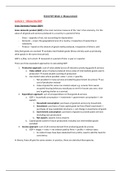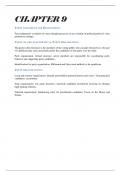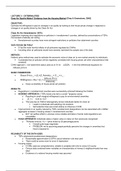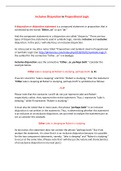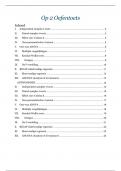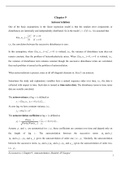Lecture 1 – Measuring GDP
Gross Domestic Product (GDP)
Gross domestic product (GDP) is the most common measure of the ‘size’ of an economy. It is the
value of all goods and services produced in a country in a period of time.
- Gross – opposite of net, not accounting for depreciation
- Domestic – covers the geographical area of a country, irrespective of ownership or
nationality
- Product – based on the amount of goods newly produced, irrespective of what is sold
Only final goods are counted → excludes intermediate goods (those entirely used up producing
other goods in the same time period).
GDP is a flow, not a stock → measured in a period of time: a year or a quarter.
There are three equivalent approaches to calculating GDP:
1. Production approach: sum of value added across all industries producing goods & services
a. Value added: value of output produced minus value of intermediate goods used in
production → avoids double counting of production
b. Use market value where possible: value = price × quantity
i. Not possible for many services provided by government (no prices) → use
cost of production instead
ii. Value imputed for some non-market output e.g. services from owner
occupied housing (what you would pay as rent for houses you own, since
you’re getting shelter as a service)
2. Expenditure approach: sum of all expenditure on final goods & services
a. GDP = household consumption + investment + government consumption + net
exports
i. Household consumption: purchases of goods & services by households
ii. Investment: purchases of new capital goods by firms (fixed investment) +
purchases of new residential structures + net change in inventories of goods
iii. Government consumption: purchases of goods to provide public services
(including own production)
iv. Net exports: exports minus imports
b. Capital goods (used for future production) included, but intermediate goods
excluded
3. Income approach: sum of all incomes derived from producing goods & services
a. GDP = wages + rents + net interest paid by firms + profits + indirect taxes
i. As indirect taxes have been deducted from profits, need to add this back for
consistency
In theory, these all give the same answer; in practice, there are statistical discrepancies.
,National income: other measures
Although GDP is the most common measure of national income, there are several variants:
• Gross national product (GNP): GDP + net international income
o Income from production earned by domestic residents, irrespective of where
production occurs
• Net national product (NNP): GNP − depreciation
o Deducts cost of maintaining existing stock of capital
• NNP at basic prices: NNP − indirect taxes
o Deduct impact of indirect taxes on market prices
Problems in the measurement and interpretation of GDP
Problems in measuring GDP:
- Difficult to obtain timely GDP data
o Initial estimates of GDP based on very limited data
o Often large revisions made to GDP
- Difficult to obtain comprehensive data on all economic activity
o Informal/underground economy
o Tax evasion
o Criminal activity
- Difficulties in measuring the output of particular sectors of the economy
o Financial services
o Owner-occupied housing → see production approach
GDP is often used as a measure of economic success, but can we say that GDP is a good measure of
welfare/living standards in a country?
If market prices reflect the value of different goods and services to consumers, adding up the value
of all output should give a fair representation of how much benefit consumers derive from economic
activity.
But, to interpret GDP as a measure of welfare, we need to make some adjustments:
- Adjust for price differences (over time or across countries): real GDP, not nominal GDP
- Divide by population: GDP per person
However, this would still only describe the welfare of the “average” person → silent on
inequality/distributional questions.
,Issues with GDP as a measure of welfare:
- Don’t have market prices for all goods
o Public services valued at cost
o Imputed rents used for owner-occupied housing
- Total benefit derived from goods greater than price
o Think of internet services with no charges (e.g. Google search)
- Costs of production not reflected in price (e.g. pollution)
- Increase in GDP might be due to more spending to deal with ‘bads’
o E.g. more crime → more police needed
- Exclusion of non-market activities
o Home production: cooking, childcare etc.
- Labour and capital treated as ‘free’
o Earning wages uses up time → better to divide income by hours of work i.e. use
productivity measure
o The capital stock must be maintained → should subtract depreciation (just as
intermediate goods are subtracted when they are used up in production)
▪ However, this is hard to do → hence ‘gross’ used rather than ‘net’
Lecture 2 – Comparing GDP
Nominal GDP
- Nominal variables are expressed in units of money
- Real variables are adjusted for changes in the value of money
o Aim to capture changes in quantities only
o Remove effects of inflation
Let’s look at a simple example where there are just two consumption goods produced in an
economy – we’ll keep coming back to this:
Haircuts: output increases by
25% and price increases by 100%
Computers: output increases by
90% and price decreases by 90%
Think of this as a simplification of the real world: haircuts represent services and computers
represent high-tech manufacturing. Also, think of the two years as being decades apart.
It’s clear that there is real growth in the economy because output of all goods increases, but how
much? Well, if output of all good grew by the same amount then it’s trivial – it would simply be that
amount. However, this is rarely the case.
Let’s start with nominal GDP growth:
- Year 1 nominal GDP: 𝑁𝐺𝐷𝑃1 = $1 × 8,000 + $1,000 × 2 = $10,000
- Year 2 nominal GDP: 𝑁𝐺𝐷𝑃2 = $2 × 10,000 + $100 × 20 = $22,000
- Hence, there is 120% nominal GDP growth between the years – how much of this growth is
real and how much is due to inflation?
, Real GDP
Now let’s look at real GDP growth at constant prices:
A common approach to measuring the change in real GDP is to hold fixed the prices from year 1
when calculating the value of output in year 2
- Real GDP in year 1 at constant year-1 prices: 𝑅𝐺𝐷𝑃1|1 = $1 10,000 (same as nominal GDP in
that year obviously)
- Real GDP in year 2 at constant year-1 prices:
𝑅𝐺𝐷𝑃2|1 = $1 × 10,000 + $1,000 × 20 = $1 30,000
- Thus, real GDP at constant year-1 prices grows by 200%
By definition, this method can’t be contaminated by inflation because no prices have changed. The
problem is that there are alternative and equally fine ways to measure real GDP which deliver very
different answers in general.
Suppose instead we calculate real GDP growth at year 2 prices:
- Real GDP in year 1 at year-2 prices: 𝑅𝐺𝐷𝑃1|2 = $2 × 8,000 + $100 × 2 = $2 16,200
- Real GDP in year 2 at year-2 prices: 𝑅𝐺𝐷𝑃2|2 = $2 22,000 (same as nominal GDP in that
year)
- So, real GDP at constant year-2 prices only grows by 36%
One measure of real GDP growth is 200% and the other is only 36% → why such a large difference?
i) Large changes in relative prices
1000
a. In year 1, the price of a computer relative to a haircut is 1
= 1000
100
b. By year 2, the relative price falls to 2
= 50
ii) Different trends in production of different goods
a. The large proportionate increase in output of computers (compared to haircuts) is
effectively more important when the value of a computer is measured by the year-1
relative price → computers more expensive in year 1, when they were scarce
b. By year 2, computers are much cheaper so there would be less importance of the
increase in output if we use these prices
However, note that using prices from far in the past can give a misleading impression of the current
importance of goods.
In the past, the most common approach to calculating real GDP used the year-1 constant prices
approach. However, by the 1990s, there was concern this was leading to overestimates of real
growth – because of the large increase in output of computers and other high-tech goods, combined
with large falls in the relative prices of such goods.
One solution to this is frequent rebasing of the real GDP measure (i.e. every 5 years), recalculating
the real GDP series with an updated set of fixed prices.
- This leads to much better measures of recent real growth rates, but still problematic for
comparison of real GDP over many decades
- Neither set of fixed prices is ideal: year-1 fixed prices overstate real growth; year-2 fixed
prices understate real growth
- Rebasing also leads to continual revisions of the historic real GDP time series


